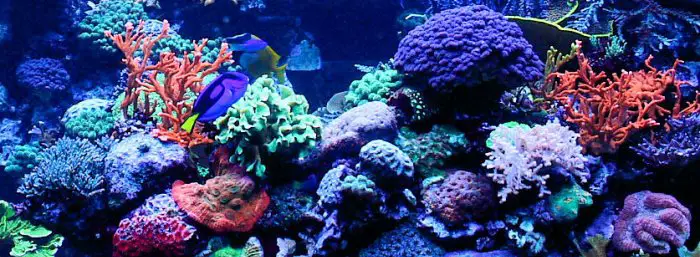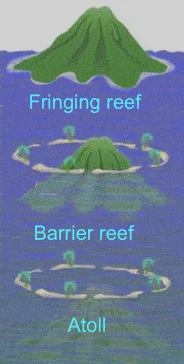The perimeter rim (also often simply called the reef rim) is highly variable in width, and generally contains two main structural elements: reef flats, and islands.
Numerous or large passages through the perimeter rim are effective at ensuring that the lagoon is flushed by daily tidal cycles, whereas atolls with almost continuous perimeter rims depend instead upon the far less effective process mechanism of wave-generated water exchange. Where tidal exchange is strong, very large and well-developed patch reefs often occur.
While waves break on all sides of those portions of the reef that reach sea level, the largest waves strike the windward margin. In these high-energy environments, the seaward margin of the reef rims generally display a prominent algal ridge dominated by calcareous red algae.
Reef Flats are shallow structures and often much of the flat is exposed during the lowest tides. On large atolls, reef flats occur in sections that often range from about 1,000 to 2,000 m in width.
Where islands are not present, a broad reef flat often comprises the bulk of the area behind the algal ridge, and extend all the way to the lagoon. In some cases, reef flats display a zonation pattern in which the algal ridge merges into a back reef zone formed by wave-scattered coral debris.
Reef islands often develop on reef rims.Islands are often more abundant on the higher energy, windward portions of perimeter rims and are characteristically low-lying land formations.
On many Indo-Pacific atolls, only about one-third of the island surface is more than 2 m above mean sea level. Such islands usually consist of a distinct seaward ridge and a lesser lagoon-ward ridge, with an intervening depression (swale) in the middle.
However, there is considerable natural variation to this basic pattern, along with (in many cases) human modification.
Waves are the main factor leading to the building of reef islands. Much of the energy of incoming ocean swells is diminished by impact with the reef rim, but some of the wave energy crosses the reef flat and reaches island shores. This in turn results in the accumulation of calcareous sediment and coral rubble, and ultimately to the building of low-lying reef islands.


